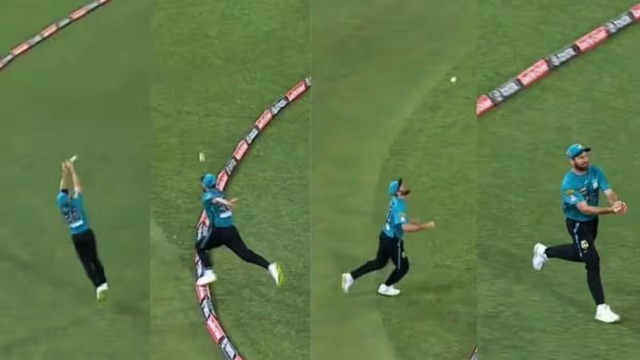The ICC will introduce a new playing condition with the upcoming Test series between Bangladesh and Sri Lanka.
The MCC, cricket’s law-making body, is set to restrict fielders’ freedom. Fielders will no longer be allowed to catch the ball multiple times outside the boundary line while airborne.
According to ESPNcricinfo, this new rule will be included in the ICC’s playing conditions starting with this month’s Bangladesh-Sri Lanka Test series and will be incorporated into the MCC Laws of Cricket by October 2026.
The ICC’s cricket committee had been considering changes to the catch rule since early this year. After handing the responsibility to the MCC, they proposed this new regulation.
A notable example came from the 2023 Big Bash, when Michael Neser jumped near the boundary and caught the ball. However, after losing his balance, he tossed the ball back into the air from outside the boundary and caught it again while airborne before landing inside the field.
A similar incident happened in the 2020 Big Bash, when Matt Renshaw and Tom Banton combined to catch Matthew Wade in almost the same way. According to current laws, the batsman was out in both cases, but these catches sparked widespread debate worldwide.
The current rule, updated in 2010, states that before a fielder first touches the ball, their last contact with the ground must be inside the boundary. In other words, they only need to be inside the boundary when first touching the ball, and can then float the ball back inside multiple times while airborne to complete the catch.
ESPNcricinfo reports that the ICC’s cricket committee informed the MCC earlier this year about reviewing this rule. The two bodies then worked together to amend it.
In a message sent to member nations via the ICC, the MCC said that while the current boundary catch rule has produced some spectacular fielding moments, it is sometimes seen as unfair or unusual by many involved in cricket.
Describing Neser’s Big Bash catch, the MCC noted the fielder performed a ‘bunny hop’—a leap while airborne—before completing the catch inside the boundary. Though technically legal, it was clear that the fielder had moved quite far outside the boundary.
Australian fast bowler Josh Hazlewood and others have recommended reverting to the pre-2010 rule, but the MCC considers that too harsh. The old rule required the fielder to remain inside the boundary after first touching the ball; if they went outside and didn’t touch the ball again inside, the catch would be invalid.
As a solution, the MCC says if a fielder goes outside the boundary and tries to catch the ball while airborne, they must bring the ball back fully inside the boundary to complete the catch; otherwise, it will count as a boundary. The new rule will no longer allow fielders to touch the ball multiple times outside the boundary like Neser did.
Under the new regulation, the MCC states that bunny hopping to catch the ball outside the boundary will be completely banned. Catches where the fielder tosses the ball back into the air from inside the field and then dives back inside to complete the catch will still be legal.
The MCC clarifies: “If a fielder jumps outside the boundary to catch the ball, they cannot touch the ball more than once before returning fully inside the field; otherwise, it will be counted as a boundary.”
This rule will also apply to relay catches involving multiple fielders. If a fielder touches the ball outside the boundary, any teammate completing the catch must ensure the first fielder returns fully inside the field.
This new rule will be part of the ICC playing conditions from the Bangladesh vs Sri Lanka Test series starting June 17, but it will be added to the MCC Laws of Cricket in October next year when other updates are introduced.






